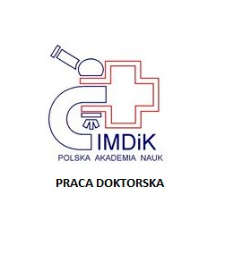- Wyszukaj w całym Repozytorium
- Piśmiennictwo i mapy
- Archeologia
- Baza Młynów
- Nauki przyrodnicze
Wyszukiwanie zaawansowane
Wyszukiwanie zaawansowane
Wyszukiwanie zaawansowane
Wyszukiwanie zaawansowane
Wyszukiwanie zaawansowane

Obiekt
Tytuł: Udział transportera glutaminy SN1 w powstawaniu obrzęku mózgu i zaburzeń w neuroprzekaźnictwie glutamatergicznym : rola w zmianach obserwowanych w ostrej encefalopatii wątrobowej
Współtwórca:
Zielińska, Magdalena (Promotor)
Wydawca:
Instytut Medycyny Doświadczalnej i Klinicznej im. M.Mossakowskiego PAN
Miejsce wydania:
Opis:
Bibliogr. str. 124-150 ; 150 s.: il., wykr., fotogr.; 30 cm
Uzyskany tytuł:
Stopień studiów:
Dyscyplina :
Instytucja nadająca tytuł:
Instytut Medycyny Doświadczalnej i Klinicznej im. M. Mossakowskiego PAN
Typ obiektu:
Abstrakt:
Encefalopatia wątrobowa (EW) jest zaburzeniem neuropsychiatrycznym. Powstaje w wyniku dysfunkcji hepatocytów, co prowadzi do obwodowego gromadzenia się różnych związków szkodliwych m.in. amoniku, któremu przypisuje się główną rolę w rozwoju choroby.Najpoważniejsze objawy kliniczne ostrej EW to: zaburzenia neurotransmisji, które w późnych fazach choroby mogą objawiać się drgawkami i śpiączką oraz obrzęk mózgu prowadzący do śmierci pacjenta. Neurotoksyczne działanie amoniaku związane jest ze zmianami w neuroprzekaźnictwie glutaminergicznym i wiąże się z nadmierną produkcją glutaminy (Gln) w astrocytach. Gln wsakzuje właściwości osmotyczne a jej gromadzenie w komórkach powoduje wystąpienie nierównowagi osmotycznej i powstawanie cytotoksycznej składowej obrzęku mózgu. Wydaje się, że przyczyną gromadzenia się Gln w astrocytach w warunkach ostrej EW jest zwiększona retencja aminokwasu w komórce spowodowana zaburzeniem jego transportu na zewnątrz komórki. Najważniejszym białkiem regulującym transport Gln z astrocytów jest SN1, który wskazuje wysoką aktywność przy fizjologicznym stężeniu tego aminokwasu. Obniżenie jego poziomu zaobserwowano w szczurzym modelu ostrej EW. Postawiona w pracy hipoteza zakłada udział astrocytarnego transportera SN1 w retencji Gln w komórkach, co przyczynia się do wystąpienia obrzęku mózgu o charakterze cytotoksycznym i zaburzeń neurotransmisji glutamatergicznej,dwóch klinicznie najpowazniejszych objawów ostrej EW.W pracy posłużono się dwoma modelami , pierwszym był mysi model ostrej EW otrzymany w wyniku dootrzewnowego podania hepatotoksyny azoksymetanu, drugim był model lokalnego wyciszenia białka , w którym wykorzystując technikę vivo-morholino, we fragmencie kory czołowej myszy zdrowej, selektywnie wyciszono transporter SN1. Otrzymane wyniki wskazują,że mysi AOM model ostrej EW u pacjentów, wykazał zaburzenia neurotransmisji glutamatergicznej (badania behawioralne i elektrofizjologiczne) oraz wystąpienia dwóch składowych obrzęku mózgu ( ultrastrukturalna analiza morfologiczna, analiza MRI , analiza 1H NMR osmolitów). Obniżenie ekspresji białka SN1 i zaburzenia transportu Gln sugerują udział transportera SN1 w obserwowanych zmianach. Lokalne wyciszenie transportera SN1 techniką vivo-morpholino spowodowało retencję Gln w astrocytach, a w konsekwencji wystąpienie cytotoksycznej składowej obrzęku mózgu )ultrastrukturalna analiza morfologiczna, analiza MRI, analiza 1H NMR i pomiar zewnątrzkomórkowych stężeń osmolitów). Co więcej, subtelne zmiany parametrów elektrofizjologicznych udokumentowały rolę transportera SN1 w utrzymaniu prawidłowej transmisji glutaminergicznej. wyniki badań pozytywnie zweryfikowały hipotezę zakładającą udział astrocytarnego transportera SN1 w rtencji Gln, prowadząc do dysfunkcji astrocytów i neuronów, co może tłumaczyć analogiczne zmiany zaobserwowane w modelu ostrej EW.
Czasopismo/Seria/cykl:
Format:
Identyfikator zasobu:
Źródło:
IMDiK PAN, sygn. ZS 386 ; kliknij tutaj, żeby przejść
Język:
Prawa:
Licencja Creative Commons Uznanie autorstwa 4.0
Zasady wykorzystania:
Zasób chroniony prawem autorskim. [CC BY 4.0 Międzynarodowe] Korzystanie dozwolone zgodnie z licencją Creative Commons Uznanie autorstwa 4.0, której pełne postanowienia dostępne są pod adresem: ; -
Digitalizacja:
Instytut Medycyny Doświadczalnej i Klinicznej im. M. Mossakowskiego Polskiej Akademii Nauk
Lokalizacja oryginału:
Biblioteka Instytutu Medycyny Doświadczalnej i Klinicznej im. M. Mossakowskiego PAN
Dofinansowane ze środków:
Dostęp:
Kolekcje, do których przypisany jest obiekt:
- Repozytorium Cyfrowe Instytutów Naukowych > Kolekcje Partnerów > Instytut Medycyny Doświadczalnej i Klinicznej PAN > Prace dyplomowe > Prace doktorskie
- Repozytorium Cyfrowe Instytutów Naukowych > Piśmiennictwo > Prace dyplomowe
Data ostatniej modyfikacji:
6 lut 2025
Data dodania obiektu:
6 lut 2019
Liczba pobrań / odtworzeń:
889
Wszystkie dostępne wersje tego obiektu:
https://rcin.org.pl./publication/89420
Wyświetl opis w formacie RDF:
Wyświetl opis w formacie RDFa:
Wyświetl opis w formacie OAI-PMH:
Obiekty Podobne
Czynniki modulujące szlaki sygnałowe związane z cyklicznym GMP w mechnizmie encefalopatii wątrobowej
Zielińska, Magdalena
Milewski, Krzysztof
Ruszkiewicz, Joanna Anita
Kraśnicka, Zuzanna Albrecht, Jan Mossakowski, Mirosław Jan (1929–2001)
Matyja, Ewa Renkawek, Krystyna Śmiałek, Mieczysław Mossakowski, Mirosław Jan (1929–2001)
Wysmyk-Cybula, Urszula

 INSTYTUT ARCHEOLOGII I ETNOLOGII POLSKIEJ AKADEMII NAUK
INSTYTUT ARCHEOLOGII I ETNOLOGII POLSKIEJ AKADEMII NAUK
 INSTYTUT BADAŃ LITERACKICH POLSKIEJ AKADEMII NAUK
INSTYTUT BADAŃ LITERACKICH POLSKIEJ AKADEMII NAUK
 INSTYTUT BADAWCZY LEŚNICTWA
INSTYTUT BADAWCZY LEŚNICTWA
 INSTYTUT BIOLOGII DOŚWIADCZALNEJ IM. MARCELEGO NENCKIEGO POLSKIEJ AKADEMII NAUK
INSTYTUT BIOLOGII DOŚWIADCZALNEJ IM. MARCELEGO NENCKIEGO POLSKIEJ AKADEMII NAUK
 INSTYTUT BIOLOGII SSAKÓW POLSKIEJ AKADEMII NAUK
INSTYTUT BIOLOGII SSAKÓW POLSKIEJ AKADEMII NAUK
 INSTYTUT CHEMII FIZYCZNEJ PAN
INSTYTUT CHEMII FIZYCZNEJ PAN
 INSTYTUT CHEMII ORGANICZNEJ PAN
INSTYTUT CHEMII ORGANICZNEJ PAN
 INSTYTUT FILOZOFII I SOCJOLOGII PAN
INSTYTUT FILOZOFII I SOCJOLOGII PAN
 INSTYTUT GEOGRAFII I PRZESTRZENNEGO ZAGOSPODAROWANIA PAN
INSTYTUT GEOGRAFII I PRZESTRZENNEGO ZAGOSPODAROWANIA PAN
 INSTYTUT HISTORII im. TADEUSZA MANTEUFFLA POLSKIEJ AKADEMII NAUK
INSTYTUT HISTORII im. TADEUSZA MANTEUFFLA POLSKIEJ AKADEMII NAUK
 INSTYTUT JĘZYKA POLSKIEGO POLSKIEJ AKADEMII NAUK
INSTYTUT JĘZYKA POLSKIEGO POLSKIEJ AKADEMII NAUK
 INSTYTUT MATEMATYCZNY PAN
INSTYTUT MATEMATYCZNY PAN
 INSTYTUT MEDYCYNY DOŚWIADCZALNEJ I KLINICZNEJ IM.MIROSŁAWA MOSSAKOWSKIEGO POLSKIEJ AKADEMII NAUK
INSTYTUT MEDYCYNY DOŚWIADCZALNEJ I KLINICZNEJ IM.MIROSŁAWA MOSSAKOWSKIEGO POLSKIEJ AKADEMII NAUK
 INSTYTUT PODSTAWOWYCH PROBLEMÓW TECHNIKI PAN
INSTYTUT PODSTAWOWYCH PROBLEMÓW TECHNIKI PAN
 INSTYTUT SLAWISTYKI PAN
INSTYTUT SLAWISTYKI PAN
 SIEĆ BADAWCZA ŁUKASIEWICZ - INSTYTUT TECHNOLOGII MATERIAŁÓW ELEKTRONICZNYCH
SIEĆ BADAWCZA ŁUKASIEWICZ - INSTYTUT TECHNOLOGII MATERIAŁÓW ELEKTRONICZNYCH
 MUZEUM I INSTYTUT ZOOLOGII POLSKIEJ AKADEMII NAUK
MUZEUM I INSTYTUT ZOOLOGII POLSKIEJ AKADEMII NAUK
 INSTYTUT BADAŃ SYSTEMOWYCH PAN
INSTYTUT BADAŃ SYSTEMOWYCH PAN
 INSTYTUT BOTANIKI IM. WŁADYSŁAWA SZAFERA POLSKIEJ AKADEMII NAUK
INSTYTUT BOTANIKI IM. WŁADYSŁAWA SZAFERA POLSKIEJ AKADEMII NAUK




































